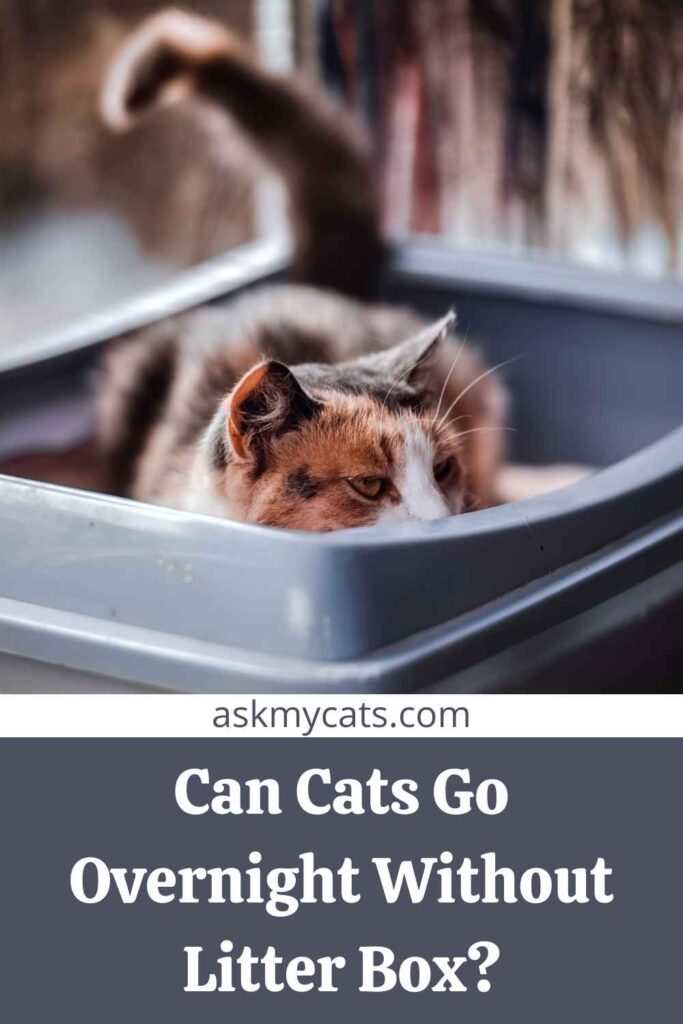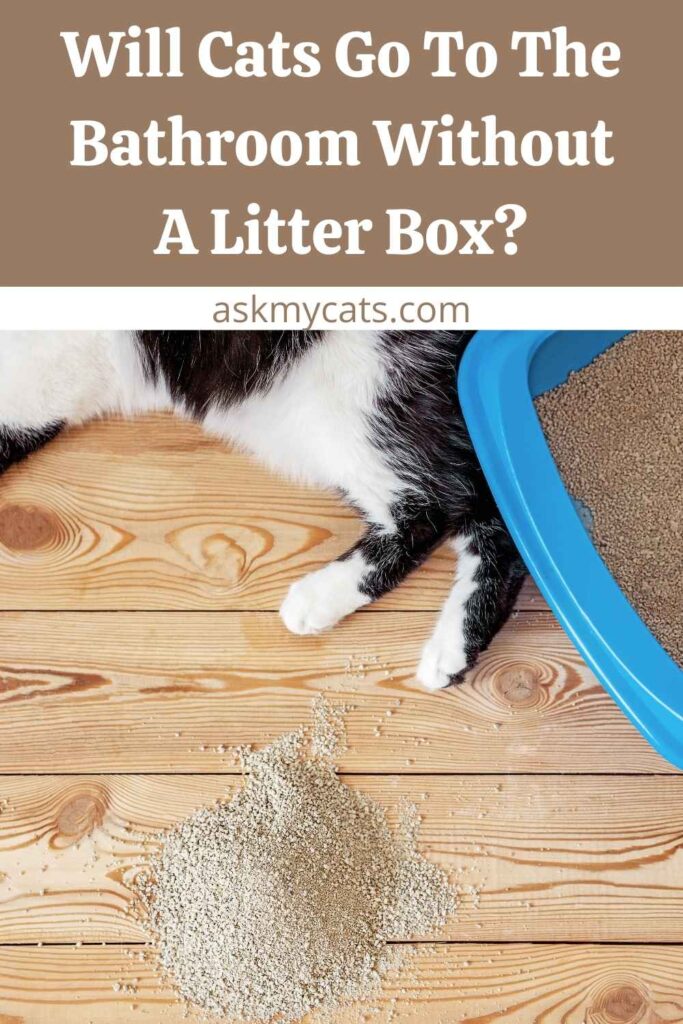Most cats, unlike dogs, will not let you know when they need to go to the bathroom. They’ve become accustomed to going to the litterbox whenever they need to relieve themselves.
However, they do not have unrestricted access to pee or defecate as necessary.
According to experts, even if they have consumed enough fluids and eaten their regular meal, cats may go for up to 48 hours without using a litter box. Indoor cats should, in most cases, have constant access to their litter box to relieve themselves.
Understanding how your cat’s bladder functions are crucial as a cat owner. You’ll be able to tell how long they can go without becoming sick if you do it this way.


Give Your Cat the Perfect Day
Get the Free Ebook!
Can Cats Go Overnight Without Litter Box?
Yes, cats can go overnight without a litter box if given proper training.

If you want to get rid of the litter box overnight, there are two options: toilet training and outdoor potty training. Toilet training isn’t suggested since it goes against cats’ natural tendency to bury their excrement and might harm animals.
Outdoor litter training is a far better alternative while keeping at least one litter box inside the house is still a good idea.
Although teaching your cat to use the litter box outside is the greatest option for litter-free toileting, it does have its drawbacks. It’s not as simple as emptying the litter box and opening the door once in a while.
Cats, unlike dogs, require regular access to their “restroom.” This means you’ll need to provide your cat with continual access to the outside or have at least one litter box inside.
When a cat is forced to ‘hold it,’ it can cause major health problems. And, more often than not, they’ll find another place to go.
Domesticated cats are a long way from their wild forefathers.
When people are forced to leave their homes, they may endure stress or worry. Even cats who are used to spending time outside may not appreciate it in certain weather conditions, when it is unusually noisy or busy outside, or when bothered by other neighborhood cats or wildlife.
Don’t push your cat to go outside if they don’t seem comfortable. Not all cats will respond to litter training in the outdoors.
T.gondii, roundworm, tapeworm, and hookworm, to mention a few parasites, can all be found in cat feces.
It might be difficult, if not impossible, to keep track of where your cat goes to the restroom outside. These parasites can spread if they utilize a vegetable or herb garden or near a water source like a creek, well, or wetlands.
If you have edible plants, wear gloves when working in the garden, wash your hands afterward, and thoroughly wash any harvested crops.
If any of your neighbors have a garden, talk to them about your ideas and make sure they’re cool with it. Allowing your cat to defecate in a neighbor’s garden without first mentioning the consequences.
If your cat is not pooping also, you should check out this: How Long Can Cats Hold Their Poop?
Will Cats Go To The Bathroom Without A Litter Box?
Yes, properly trained cats will access the bathroom without a litter box.

Even if your cat is used to going outside, it’s a good idea to maintain at least one litter box inside in case of an emergency. There are a few advantages to doing so.
To begin, wild cats use urine to mark their territory. Using a litter box inside the house might also help your cat feel at ease in your home.
Second, keep in mind that allowing your cat frequent outside access also invites unwanted visitors into your house. At night, when it’s dark and calm, wild creatures are considerably more likely to slip in.
Indoor-outdoor cat owners frequently prefer to keep their pets inside at night. Both for their protection and to keep unwelcome guests out, they should lock the pet door.
However, you won’t be able to shut the cat door unless you have at least one indoor litter box.
To teach your cat to use the litter box outdoors, begin by relocating one of your cat’s litter boxes near the front door. At the very least, one should still be in your house. Allow your cat to investigate the new setting.
Gradually relocate the outside litter box nearer your ideal position as they develop more acquainted with it. Your cat will eventually roam anywhere they want, but it’s worth a try.
Remove the litter box and replace it with a pile of litter immediately on the ground after it’s in the appropriate position and they’re using it regularly. Place some of their fresh feces in the litter to let them know it’s “all right” to use this area.
Reduce the amount of litter you use as your cat gets more at ease.
Remember that your cat must be at ease when using the potty; otherwise, their health may be jeopardized.
For your convenience, don’t force your cat into preferred potty habits. Also, don’t rush through the procedure. Change takes time for cats to acclimatize to, and the more time they have, the better.
Also, check out Do Cats Pee And Poop At Night
Will A Cat Poop Without A Litter Box?
No, a cat will never poop without a litter box until it eventually explodes if he is not properly trained.

You don’t want to be in the vicinity when it occurs. The same habit that kittens exhibit in the litter box will inevitably spread outside. They’ll seek a secret location, scratch a spot, eliminate it, and then hide their waste.
Like many other pets, Cats have an almost instinctive capacity to learn how to use the potty in a certain location. Litter box training comes easy to cats, preventing late-night visits outdoors as well as the inevitable mishaps that come with training other pets.
Urinary tract illness is a common cause of cats wetting or urinating beyond the litter box. Urinary tract infections, also known as feline lower urinary tract disease (FLUTD, or idiopathic cystitis), can be unpleasant, increase a cat’s desire to go, and prevent them from doing so regularly.
Small quantities of pee in various locations about the house, straining to urinate, and blood in the urine are all frequent signs.
You might also like to read about do cats need litter box at night
Medical conditions that drive cats to drink and pee more frequently, in general, might result in a cat not using the litter box. Diabetes, hyperthyroidism, and kidney or renal illnesses are examples.
Arthritis is a frequent condition that can cause a cat to defecate on the floor instead of in the litter box or to pee over the litter box’s edge. Lifting the rear legs to walk over and into the litter box might be unpleasant if you have arthritis. When a cat poops, it can also be difficult to assume a normal posture.
Cats will frequently defecate or pee near the litter box but not enter it. They may also exhibit additional symptoms such as difficulty walking, jumping difficulties, or soreness along the spine when petted.
Gastrointestinal (GI) illness is another medical reason for pooping outside the litter box. Cats are prone to constipation. Dehydration from renal illness, hyperthyroidism, megacolon, or other intestinal disorders can all contribute.
Cats usually go to the toilet infrequently, straining to defecate or pee and having only tiny, dry bowel movements.
On the other hand, diarrhea or loose feces might make it difficult to go to the litter box because the desire to go can strike at any time. Gastrointestinal infections and stress frequently cause diarrhea.
Find out more details about how long can cats go without food
What Happens If A Cat Doesn’t Have A Litter Box?
If a cat doesn’t have a litter box, then he will eliminate it outside.
Elimination issues might arise due to a disagreement between numerous cats in the home, distaste for the litterbox type or the litter itself, a previous medical condition, or the cat deciding she doesn’t like the position or placement of the litter box.
When a cat avoids using the litter box for whatever reason, it can become a chronic problem because the cat develops a surface or location preference for elimination, which could be your living room carpeting or your favorite easy chair.
The best way to handle these issues is to prevent them from occurring in the first place by keeping your cat’s litter boxes as cat-friendly as possible.
You might also like to read about how long can a cat go without peeing
Frequently Asked Questions
Can cats be toilet trained?
It is not difficult to toilet train your cat. It simply takes a little patience, time, and the correct tools. The potty training method will shape your cat’s behavior and help them transition to using the toilet for you in a gentle (and hopefully clean!) manner.
How do you know when a cat needs to go to the bathroom?
Sniffing the ground, meowing, and darting under the sofa are all indicators that your kitty needs a potty break. Keep an eye out for your kitten and gently direct him to the litter box or place him in it to offer him some privacy. Try not to gaze too intently since he will feel more at ease if not watched.
How often do cats poop and pee?
Every day, keep track of how frequently and how much your cat defecates. A typical adult cat defecates once every 24 to 36 hours, producing a stool roughly the size of a Tootsie Roll candy bar.
Final Words
While it may appear to be a good idea in theory, going litter-free has several drawbacks. Toilet training your cat instead of litter training may inflict psychological harm to your cat and damage the environment.
It’s fine to teach a cat outside, but it’s still a good idea to have at least one indoor litter box.
Whatever you choose, keep in mind that your cat’s comfort is paramount. Don’t force them to adjust to their new restroom environment if they aren’t ready. Scooping litter isn’t all that difficult.
Ask your questions in the comments section below.
